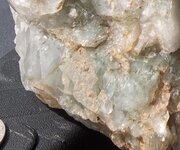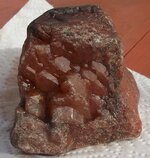G Freeman
Sr. Member
- Aug 22, 2013
- 476
- 230
- Detector(s) used
- Fisher Gold Bug.
- Primary Interest:
- All Treasure Hunting
BB, I'm not a crystaline structure specialist, not a mineral specialist, not a chemical specialist,
but I did stay at a Holiday Inn last night.
If we are/were talking beryl, we would be talking Bixbite. I figure with the emeralds in the carolina areas, there would only have to be the right mineral composition, to create Bixbite, vs heliodor or aquamarine, talking beryls, I mean. Follow me?
I have heard of one instance of Bixbite being found (in the Carolinas, I thought), and of course, I could probably never find, where I seen that.
Like I said, I have dreams of me or someone finding that red emerald mother load vein!
Beryl: The mineral Beryl info & pictures (aquamarine, emerald)


BruntBear I think I have got a lot of Aquamarine from this site as it is blue green but very light blue crystals. Got to turn the crystals a certain way in shade of the lamp to see the blue in them. Does that make sense? Also under black light I found 4 places that flourese a bright orange red and it is just little specks of red but they are so bright under UV light but with regular light can't see them.
Raw aquamarine has subtle shading, from what I have seen. It's almost like, it isn't even there.
I thought they heat treated aquamarine to bring out color? Please do correct me if I am mistaken.
I'm trying to determine if the fluorescence you're seeing isn't some sort of reflection from the UV. Reason being that the fluorescent spot is perfectly round. That's probably something you can determine on your end in person though.
Something I noticed about the other crystal you found; it appears to have a Rhombic-type structure as well. I cropped your pics that I saved to show you what I mean.
View attachment 1082435 View attachment 1082436
Both of these specimens strangely resemble Fluorite, but Fluorite is very soft. The blue-green crystal really looks like Fluorite and Dolomite.
There is a simple reason why that happens. Pleochroism is what the phenomena is called. Many minerals show it, but only a few crystal systems show only 2 colour.
To put is simpler:
The light is bent differently in different directions of the crystal. So you see different colours. (or hues)
Aquamarine (hexagonal crystals) bend light in 2 different directions, down the length of the crystal and 90 degrees to that. (or, if put standing on a table, vertical and horizontal)
Corundum (trigonal crystals) show the same effect. Quartz to, but often not as apparent.
One of the most known minerals which show this is tourmaline.
It's also the reason they are so often cut into rectangular shapes; since down the length of the crystal they often are near black.
This is more in depth and technical:
Pleochroism - The Gemology Project
Either way, back to the unknown specimen. What kind of rock did you pull it out of? Do you know?
Yeah.. White streaks have fooled me more then once, to. LOL
Do a new hardness test to be sure, knife and quartz. Wipe of any white streaks before checking with the loupe, and don't be afraid to use a little bit of force.
If its harder then the knife you'll see a metallic line on it rather then a scratch.
Aquamarine is usually inert in UV light. Most Beryls are. Goshenite (clear) can fluoresce pale yellow or pink in both SW & LW.Heat treatments can be used to enhance the color in Aquamarine. It is usually very pale blue or green-blue. As far as the UV fluorescence, I'm going to have to research that. Very interesting.
Eu I am not talking about the red rock with the crystals but another crystal that I will post tomorrow when I have sunshine to get pictures outside..Eu I pulled this crystal from a vein of crystals many of them when I first started getting into rocks and digging for them about a year ago. I put them out of the way at home and just lately got them out of storage after you guys got me looking for colour in crystals. I remember some of these crystals had colour in them. Saw these crystals in the ground in the vein looked blue green in the ground. When I took them from the ground in sunlight the colour was weaker so I just put them away here at home. The vein had nothing but crystals in it so I did not take these out of a rock and they came out of the ground as all crystal. Hope that helps. Thank you for everything and trying to help me. I am trying to learn everything I can from you guys and gals that know a lot more than me.
This specimen could possibly be red Cuprite.
Check out this photo of some:
http://www.mindat.org/photo-651727.html
 *frowns* Been picking at this for a week now. Another candidate might be a form of vanadium but I cant track down a good source for images and data...
*frowns* Been picking at this for a week now. Another candidate might be a form of vanadium but I cant track down a good source for images and data...DDancer Can't swear by my calculations but the red pink rocks SG IS 2.68 if that helps. Thanks.Interesting idea BB but its not hard enough. Cuprite is about a 4 for hardness. The pictures look alike though. I'm wondering if its some odd form of garnet about now*frowns* Been picking at this for a week now. Another candidate might be a form of vanadium but I cant track down a good source for images and data...
They are generally darker red, but there are lighter tones out there. Here is a photo of some lighter color red:
View attachment 1089860
Oh, definitely not Cuprite then, lol. Cuprite is like 6.1 or something.